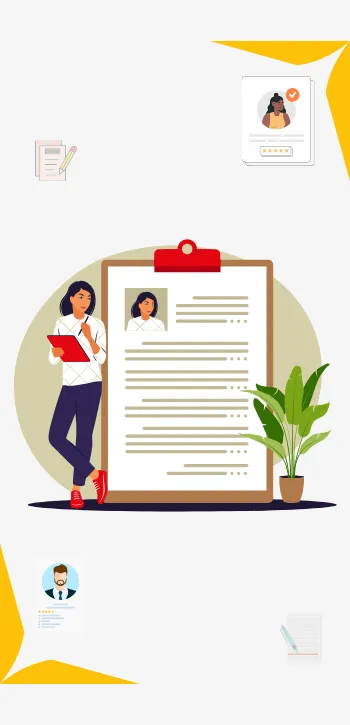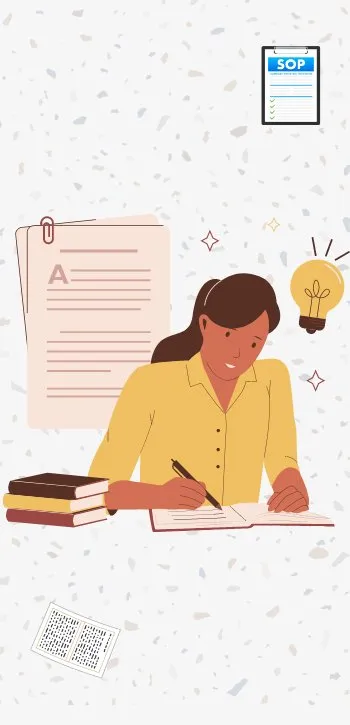
Duolingo English Test: How to Prepare?
In this blog, we have dealt with the tips & tricks to ace the Duolingo English Test that might help students achieve success & land their dream universities. In the recent world of competition, understanding the test ensures greater success & better chances of success. The Duolingo English Test is a standardised measure to analyse the English Proficiency of students & help them get into their desired universities.
- Introduction of Duolingo English Test
- Duolingo English Test: Fees, Score, Mode & More
- Duolingo English Test Validity
- Test Pattern of the Duolingo English Test
- Duolingo English Test: Exam Pattern & Divisions of Test
- DET’s Major Segments
- Question Types & Frequency
- Preparation Before Exam
- During the Exam
- Some general tips
- FAQs
Introduction of Duolingo English Test
The Duolingo English Test is a standardised exam created by Duolingo to evaluate the language abilities of international applicants. The exam is more affordable than the IELTS and TOEFL. Therefore, the testing process is more convenient when candidates can take the exam at any location and time.
Duolingo English Test: Fees, Score, Mode & More
The Duolingo English Test is a standardised measure that assesses the reading, writing, speaking & listening skills of the students. The test is 60 minutes long
which is taken in online mode. The score of the test ranges from 10-160. A test score above 110 is considered a good score for university acceptance. However, it may vary from university to university. The Duolingo test fee is $65 or 5,425 rupees in India.
Duolingo English Test Validity
Students get their results within 2 days after the examination & it remains valid across the globe for 2 years
Also read – TOEFL A Complete Guide
Test Pattern of the Duolingo English Test
The test is divided into 3 major sections, which include introduction, adaptive test & video interaction. The introduction section is 5 minutes long, mainly to ensure the functioning of microphones, webcams, and internet connectivity. This is followed by the adaptive test, which is further divided into 3 major sub-sections. It includes reading, writing & listening. This section lasts for 45 minutes. The last part of it is the video interaction section, which is 10 minutes long and measures the speaking ability of the students.
Duolingo English Test: Exam Pattern & Divisions of Test
The table listed below helps us to better understand the pattern of the test & its major sections. The introduction helps the students to check the workings of their hardware. This is followed by the adaptive test & video interaction.
| Section | Duration | Description |
|---|---|---|
| Introduction | 5 mins | To check the workings of microphones, webcam, connectivity, etc. Students need to submit their govt IDs for proof. Candidates go through the guidelines and pattern of the test. |
| Adaptive Test | 45 mins | The test is divided into 3 sections: Reading Writing Listening |
| Video Interaction | 10 mins | A video interview allows to analyse the speaking ability of the student |
DET’s Major Segments
The adaptive test is subdivided into 3 sub-sections, which include reading, writing & listening. We have given a detailed analysis of it along with the types of questions asked in the test.
Reading
In this section, candidates are required to read short passages and answer the comprehension questions. This can be in the form of fill-in-the-blanks, multiple-choice questions, etc.
Types of questions
- Read and Select: Read all the words in English & select the most appropriate word which describes the correct word in English
- Read & Complete: Read the given sentence & type the missing letters to complete the sentence below.
- Read Aloud: Read aloud the given sentence & record your response.
- Read & Complete: Read the passage & choose the most suitable words to complete the sentence.
- Highlight the Answer: Read the passage & highlight your answer from the given passage.
- Title the passage: Read the passage & find a suitable title for the passage from the given options.
Writing
This section involves 2 open-ended questions which require written responses from the students. Other questions in this section can be in the form of fill-in-the-blanks, responding with a written answer to the audio clip, etc.
Types of questions
- Fill in the blanks: Read the sentence with an unfinished word & then fill in the blanks to complete the word.
- Listen & Summarise: Listen to the audio clip & summarise the conversation.
- Write about the Photo: Write a description of the image shown for 1 minute.
- Interactive Writing: Write about a given topic for 5 minutes.
- Writing Sample: Under this section, write about a topic for 5 minutes.
Listening
Candidates are required to respond to the audio clips or passages shown in this section & are required to answer them accordingly.
Types of questions
- Listen & Type: Listen to a person speaking & you will transcribe what you hear.
- Listen & Respond: Listen to an audio clip once & select the most suitable response to continue a conversation.
- Listen & Speak: Listen & then speak about the topic for 90 seconds.
Video Interaction (Speaking)
The section involves speaking responses based on the questions asked.
Types of questions
- Speaking Sample: Speaking Sample asks you to speak about a topic for 3 mins
- Read & then Speak: Speak about a given topic for 90s seconds based on the questions asked about the topic.
- Speak about the Photo: Speak about the Photo asks you to speak on a given image for 90 seconds.
- Listen & then Speak: Listen & then Speak asks you to listen to the given audio & speak about the topic for 90 seconds.
The section helps us to break down each section & understand the types of questions, their frequencies & underscores. This segmentation makes the process of examination smoother for students.
Table
Question Types & Frequency
The section helps us to break down each section & understand the types of questions, their frequencies & underscores. This segmentation makes the process of examination smoother for students.
| Question Types | Subscores | Frequency |
|---|---|---|
| Read & Complete | Literacy & Comprehension | 15-18 |
| Fill in the blanks | Literacy & Comprehension | 6-9 |
| Read & Complete | Literacy & Comprehension | 3-6 |
| Read Aloud | Comprehension & Conversation | 3-6 |
| Listen & Type | Comprehension & Conversation | 6-9 |
| Interactive Reading | Literacy & Comprehension | 2 sets of 6 questions |
| Interactive Listening | Comprehension & Conversation | 2 sets of 5-6 question |
| Write about the photo | Production & Literacy | 3 |
| Interactive Writing | Literacy & Production | 1 set of 2 questions |
| Listen, then Speak | Conversation & Production | 2 |
| Speak about the photo | Conversation & Production | 1 |
| Read, then Speak | Conversation & Literacy | 1 |
| Writing Sample | Literacy & Production | 1 |
| Speaking Sample | Conversation & Production | 1 |
Preparation Before Exam
Speaking
- Take advantage of the time & utilise it by speaking to yourself or narrating a tale. While watching some movies and video clips in English, you can repeat what you hear to give a nice twist to your tongue.
- There are some sounds or sets of sounds which might be challenging to pronounce. Under such circumstances, refer to Google pronunciation & practise new words by speaking them to yourself.
Reading
- Read books, e-books, and blogs in English to give a pace to your reading skills.
- Students can also read articles in newspapers and magazines to develop their knowledge.
- Develop the ability to read fast. You can also use a stopwatch or timer to measure your speed.
Writing
- Start with easy, stress-free writing. You can start writing your journal in English.
- You can make your to-do list and your bucket list in English. Once you gain interest, try writing up the essential things that you read in your own words in English. This allows freedom & helps students to develop an interest in writing.
Listening
- Start with Music. Since music is the best muse, try listening to some English music that helps you to develop interest.
- You can also listen to some English video clips or watch English movies that help you to understand the words. You can even watch your favourite movie in English.
- You can listen to news and podcasts in English.
During the Exam
Let us understand the tips to ace the 4 sections within 60 minutes.
Reading Comprehension
- Begin with the section that you are most sure about
- Create an account in the Duolingo app to be familiar with the questions.
- Start preparing for the free mock tests available on the Duolingo app.
Writing
- Use proper grammar, punctuation & capitalisation.
- The Duolingo app accepts British & American spelling. The only exception is the Read & Complete question which accepts American English only.
- Vary your sentence structure & word choice as much as possible.
- Using diverse & sophisticated vocabulary & grammar can help you achieve a better score.
Speaking
- Speak loudly, clearly & at an understandable pace
- You will not have a chance to re-record yourself. So, even if you make a mistake, just keep going.
- Make sure you don’t submit your score until after you have finished your entire response.
Listening
- Listen to the audio questions carefully.
- In case you are not sure about the answer, don’t click on “Submit.”
- Leave time at the end to check your responses before submitting.
Some general tips
- Try to avoid looking at the timer too often.
- Leave time after each question to re-check your answer
- If you can, give a long answer to the question within the specified time. This helps you to score fast.
- Don’t hurry. You will not get extra marks for answering faster.
- Take time to answer the question. Because once you click “NEXT” you cannot return to a question.
FAQs
What is a good score on the Duolingo English Test?
A score above 110 is considered as a good score. If a student scores above 120 it is considered an excellent score.
How does the Duolingo English Test work?
The Duolingo Test measures the English proficiency of the students through a series of questions. The test is divided into 3 major sections, in which the 2 major sections test the reading, writing, listening & speaking abilities of the students.
How many times can I take the Duolingo English Test?
Students can take as many attempts as they want, but the free tests can only be taken if a candidate still has attempts remaining on the credit.
If you are an aspirant looking to study at your dream university, book an appointment with AdmitX today and start your applications early to avail yourself of all the benefits.









